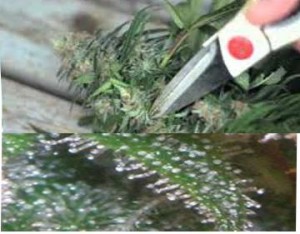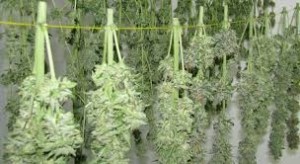
The benefits of taking the time to research what you need to know, working hard, purchasing quality products and equipment…doing things right are well worth the expense for a bountiful harvest.
Keeping cannabis plants healthy from pests and disease-free will help to ensure a quality crop. Harvesting plants at their peak ripeness, based on the qualities of the high that you like is important since the window for peak ripeness with marijuana lasts for 5 – 7 days.
To avoid buds tasting like fertilizer, it is best to flush your plants with a clearing solution or by using plain water for the last week or two of flowering. By not watering your plants for 1 – 2 days will help the drying process to happen much faster.
A Few Indicators To Tell If Fertilizers Will Affect The Taste of Your Buds Are:
- Nutrient burn is showing on leaves.
- If leaves are brittle before and when harvesting.
- When smoking, it crackles when burning (this can also occur if seeds are in it).
- The buds smell like fertilizer.
- Buds taste like fertilizer.
- The more white the ash there is when burned, the more flushed or organic the plant is.
Once you have harvested the buds from the branches of your plant, you will want to manicure the buds to have a nice appearance and be free of excess leaves. Properly harvesting cannabis will help to preserve the THC in the buds before drying them.
The fragrance of cannabis is always a problem when harvesting your crop. You will want to control strong odor when harvesting and keep the room well-ventilated with filters as well as air neutralizers to prevent the fragrance from escaping the room.
When To Harvest Marijuana Garden

Once the flowers have been cut from the female plant the production of THC stops and will not increase anymore. When you are handling the female buds that you have cut from the plant, be sure to handle them with care.
The more you touch and handle the buds, the more THC resin will be lost due to handling. If you allow harvested buds to be exposed to prolonged periods of temperatures above 80°F (27° C) and humid or damp conditions these will all degrade the quality of the THC on the buds.
THC is produced not only in female plants but also in male plants in much, much lower concentrations. The THC is produced in the female flowers and also produced in the leaves and stems.
The trichomes on the female plant are referred to as ‘resin glands’ or ‘trichomes’. When harvesting cannabis the grower must first pull off all of the large water or shade leaves before they begin cutting the buds off.
After the large leaves are cut off then you begin manicuring or trimming off all of the smaller leaves that are closer to the bud. Once the buds are manicured many growers hang the branches upside down because it is simple, convenient, and effective for harvesting cannabis.
Leaves From Harvesting Cannabis

Small leaves around the flowering buds continue to develop THC until the buds reach peak ripeness. When you are harvesting your crop, you will want to separate all of the leaves into two categories.
The first category is the water or shade leaves and all dead leaves. These you can just throw away as they contain very, very little THC and are not worth keeping.
The second category of leaves is the smaller ones that are closer to the buds. Along with the smaller leaves, the leaf stem (petiole) should be kept as well, since they too contain THC.
These leaves are considered to be trimmings and are worth keeping for later use to make butter, oils, or hash. To be able to use these trimmings for making butter, oils, or hash; they will first need to be dried out after harvesting cannabis.
Most growers tend to use brown paper bags, cardboard boxes, or wood boxes to place them in. Whichever one you choose to use to store your trimmings in to dry it is important the container needs to be able to breathe so the trimmings do not mold.
Plastic bags and fully sealed containers do not work well for drying trimmings. When placing the trimmings into a container it should be no more than one (1) inch deep of trimmings.
Any more than that, the risks of mold are greater. The trimming container needs to be stored in a place with 40% – 60% humidity and at a temperature of 60 – 70° F (12 – 21° C).
With this amount of humidity, the trimmings will be dried within five (5) to seven (7) days. You can speed this process up more by allowing the humidity to be slightly lower than 40%.
Let us know what you think.




Responses